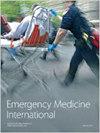急诊科乳酸对严重呼吸困难患者的预测作用
IF 0.8
4区 医学
Q3 EMERGENCY MEDICINE
引用次数: 0
摘要
目的。在急诊科(ED)中,准确识别需要优先诊断和护理的病人至关重要。血气(BG)分析是一种广泛使用的实验室检测方法,可测量包括通气和灌注指标在内的生命参数。我们分析的目的是评估急诊科收治的呼吸困难患者中呼吸衰竭风险较高者的血气参数是否能预测短期预后。研究方法研究小组最终由 108 名可进行血气分析的患者组成。对临床和实验室参数进行了回顾性评估,并分为三组--动脉血气(ABG)、静脉血气(VBG)和混合血气。主要终点是随访中位数(1分位数-3分位数)2(1-4)个月期间的短期全因死亡率。评估了从血气采样中获得的导致死亡的独立风险因素。结果显示短期死亡率为 35.2%(38/108)。死亡患者最初多被分到红色分诊风险组,合并症较多,入院时的中位SpO2明显低于随访期间存活的患者。在多变量分析中,乳酸是预测死亡的最强独立指标,在 ABG(95% CI:1.01-2.47)、VBG(95% CI:1.13-2.88)和混合血气分析(95% CI:1.22-2.31)中,1 毫摩尔/升乳酸会使全因死亡率增加 58%,在 VBG 和混合组中,校正碱过量后仍有显著意义。在各组中,pH、pO2 和 pCO2 都不能预测短期死亡率。结论对于因呼吸困难而被送入急诊室、有呼吸衰竭风险的患者,动脉、静脉和混合血液样本中的乳酸水平是短期死亡率的独立预测因子。本文章由计算机程序翻译,如有差异,请以英文原文为准。
The Predictive Role of Lactate in the Emergency Department in Patients with Severe Dyspnea
Objective. An accurate identification of patients at the need for prioritized diagnostics and care are crucial in the emergency department (ED). Blood gas (BG) analysis is a widely available laboratory test, which allows to measure vital parameters, including markers of ventilation and perfusion. The aim of our analysis was to assess whether blood gas parameters in patients with dyspnea at an increased risk of respiratory failure admitted to the ED can predict short-term outcomes. Methods. The study group eventually consisted of 108 patients, with available BG analysis. The clinical and laboratory parameters were retrospectively evaluated, and three groups were distinguished—arterial blood gas (ABG), venous blood gas (VBG), and mixed blood gas. The primary endpoint was short-term, all-cause mortality during the follow-up of median (quartile 1–quartile 3) 2 (1–4) months. The independent risk factors for mortality that could be obtained from blood gas sampling were evaluated. Results. The short-term mortality was 35.2% (38/108). Patients who died were more frequently initially assigned to the red triage risk group, more burdened with comorbidities, and the median SpO2 on admission was significantly lower than in patients who survived the follow-up period. In the multivariable analysis, lactate was the strongest independent predictor of death, with 1 mmol/L increasing all-cause mortality by 58% in ABG (95% CI: 1.01–2.47), by 80% in VBG (95% CI: 1.13–2.88), and by 68% in the mixed blood gas analysis (95% CI: 1.22–2.31), what remained significant in VBG and mixed group after correction for base excess. In each group, pH, pO2, and pCO2 did not predict short-term mortality. Conclusions. In patients admitted to the ED due to dyspnea, at risk of respiratory failure, lactate levels in arterial, venous, and mixed blood samples are independent predictors of short-term mortality.
求助全文
通过发布文献求助,成功后即可免费获取论文全文。
去求助
来源期刊

Emergency Medicine International
EMERGENCY MEDICINE-
CiteScore
0.10
自引率
0.00%
发文量
187
审稿时长
17 weeks
期刊介绍:
Emergency Medicine International is a peer-reviewed, Open Access journal that provides a forum for doctors, nurses, paramedics and ambulance staff. The journal publishes original research articles, review articles, and clinical studies related to prehospital care, disaster preparedness and response, acute medical and paediatric emergencies, critical care, sports medicine, wound care, and toxicology.
 求助内容:
求助内容: 应助结果提醒方式:
应助结果提醒方式:


